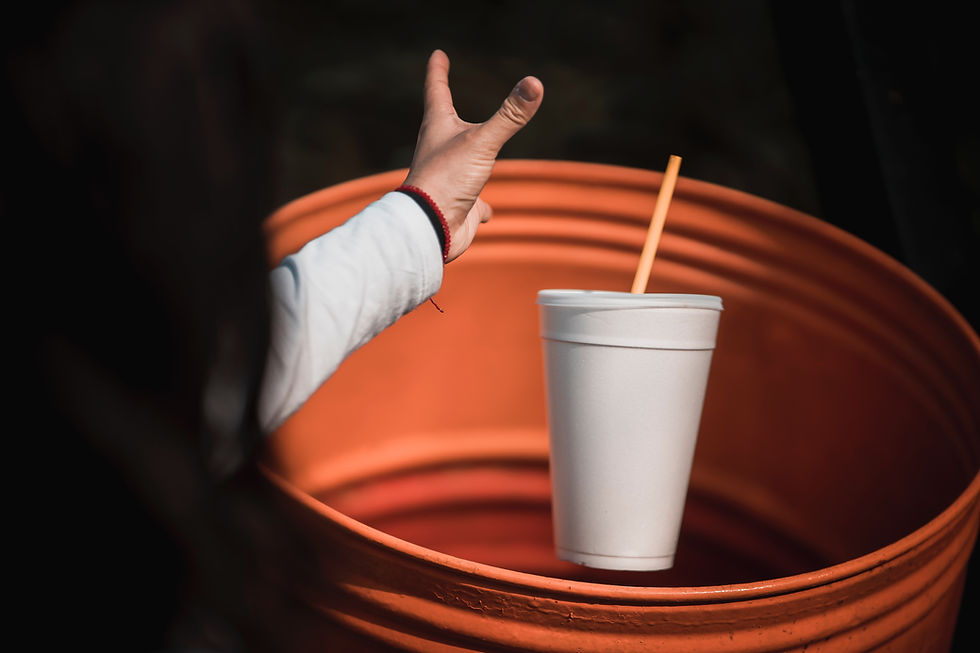My Case Against Plastics
- Greenish
- Sep 18, 2022
- 4 min read
Updated: Oct 26, 2022
I recently noticed that since going greenish, I feel more hopeful and empowered by the small, yet rewarding changes my family has made—like when my kid puts the third banana peel of the day in the compost bin, when I fish out only one unnecessary catalog from our mailbox…It feels good to be doing something good for the earth.
And then, I think about plastics. Oh, how I’ve struggled to make any greenish headway on this one. So here’s one way I can try make a difference: focusing this post on my emphatic case against plastic, and why we all need to rethink our relationships with it.

Easy to love, hard to recycle
We all love plastic. It’s cheap to make, lightweight, versatile, and everywhere. And I mean everywhere. Water bottles, packaging, textiles, cookware, toys, your food (yes, FOOD), clothing, etc.
Since plastic production began in the 1950s, 8.3 billion tons have been produced globally. Experts expect we will have generated 34 billion tons of plastic by 2050.
And plastic production is predicted to double in the next 20 years.
The problem with plastic
Despite our best recycling efforts, plastics aren’t truly recyclable. For starters, only about 9% of all plastics in the U.S. get recycled. And “recycled” really isn’t an accurate description here.
Every time plastic gets recycled, it degrades a little. So a piece of plastic might be recycled ten times total, but it’s more likely that it’s remade into something 1 or 2 times. The uses for recycled plastic are limited, so plastic that’s recycled is usually made into a lower-value product (known as downcycling). Eventually, these plastics will end up in landfills, incinerators, or waterways and oceans.
It’s worth mentioning that other materials like glass can be recycled in a closed-loop system over and over without losing integrity. And unlike glass and paper, plastic is not derived from a renewable resource. It’s a by-product of natural gas and petroleum production.
A toxic relationship
There’s a lot of info out there about the health risks associated with toxins that can leach from plastics, like BPA and Phthalates. But really, there are many more health risks associated with toxins in our plastic that we don’t fully understand yet. Plastics that end up in oceans and waterways are of particular concern because they get consumed by wildlife. And incineration under poor conditions can produce harmful pollutants that can contribute to climate change, particularly in underdeveloped countries.
It's complicated
Plastic’s “end of life” is complicated. The massive amounts of produced plastic, its low recyclability, and its uncertain degrading process make dealing with its waste challenging. So where does plastic go to die?
The vast majority of plastic will end up in landfills. The rest is either incinerated or ends up in oceans often to be consumed by wildlife, wash up on shores, or collect in what are called plastic patches.
The bad news is plastic patches stick around for a long time. The science is all over the place, but the best guess is that plastic water bottle you’re drinking from will be around for another 450 years as it breaks into tiny pieces called microplastics. It’s like glitter: it’s small, gets everywhere, and never really seems to go away.
This plastic waste problem just got even bigger. Until 2018, like many countries, the US was paying China to handle it. 70% percent of the world’s plastic waste was being shipped around the globe for them to deal with. Seems inefficient and unneighborly to send our plastic waste across the planet—and China thought so too, so they stopped accepting our plastic. Right now, the world is scrambling to figure out what to do with the plastic that’s literally accumulating in our own backyards.
The good news
While plastic will never be truly recycled, I’m encouraged by the growing number of industries working to divert plastics from landfills and prolong their usefulness.
A few examples of reusing plastic include turning them into workout leggings, outdoor furniture, reusable totes, phone charger cords, and many more.
Scientists are looking at everything from managing plastic waste more safely to using plastic as a clean energy source. Businesses are recognizing that customers value more sustainable manufacturing. And a pledge to develop an International Plastics Treaty by 2024 was signed in Kenya. That’s a pretty big deal.
But what about my plastic problem? For me, going plastic-free is an entirely ambitious—and impossible—idea. But I’m determined to make a dent in our plastic consumption with a few key changes. Because after all, going greenish means some action is better than no action.
So, the first solution to my plastic problem is straightforward. REFUSE. Yes, reusing, repurposing, and recycling all have a place in my plan. But the biggest power move by far (and maybe the least confusing) is to refuse as much plastic as possible--particularly single-use plastics.
50% of plastic produced each year is single-use and virtually impossible to recycle into anything useful. That Walgreen’s plastic bag or a bottle of flavored water will likely never become yoga pants, so I’m going to say no to them.
Want to hear more about my plastic plan? Follow along to learn everything our family is doing to make plastic less prevalent in our home.


Comments